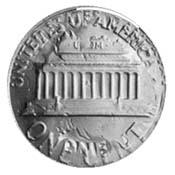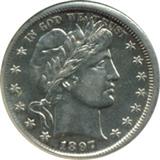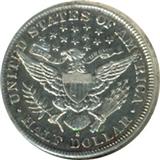Double strikes, off-centers die caps and more
We all know about the hammer and anvil dies. But we sometimes overlook the collar
die and its significance in the coin-striking process, especially as it relates to the production of error coins. The collar
is the third die in the coining chamber; a device which surrounds the edge of the planchet as the coin is struck. The collar
die keeps the coin metal from spreading larger than its intended diameter. The collar die also imparts the edge design,
if any, onto the struck coin. The edge design includes such elements as the reeds, words, symbols or other edge devices.
Even the flat, smooth finishes on the edges of coins like cents and nickels are considered to be "edge designs" imparted by
the collar die.
Multiple Strikes Inside the Collar Die
Multiple strikes inside the collar fall within two realms: intentional and unintentional. In the intentional realm, there
are proof coins and presentation pieces which are intentionally struck multiple times within the collar and usually have
single, high-quality images. The intent is to manually strike these coins multiple times to sharpen the quality of the design
for collectors or for presentation purposes. But things can go amiss even during controlled, manual striking.
If the "in-collar" coin happens to rotate between strikes (or, more likely, if a loose hammer die rotates slightly between
strikes) then the struck coin may receive multiple, in-collar images. The last of these multiple strikes will retain the
sharpest image; with the images from the former strikes being mostly obliterated by each of the subsequent strikes. And,
though it's uncommon to find a proof coin with multiple, rotated images, it does happen. Multiple images may also occur on
proof coins if a loose hammer die doesn't rotate but, instead, it cants or shifts off-center. This slightly-cocked die may
impart multiple, overlapping images on a proof coin - usually one-sided.
Die Cap
In the unintentional realm, usually during the mass production of business strikes, when the ejector mechanism fails, an
in-collar coin continues to receive additional strikes. The striking pressure eventually causes the coin to begin to get
thinner with the edges of the coin beginning to squeeze up and out of the collar die, forming a cup-shape or thimble-shape.
The sides of the cup- or thimble-shaped coin begin to form-up around the hammer die. The more strikes, the larger/taller the
thimble-shaped coin becomes. Some of these thimble-shaped coins actually, eventually adhere to the hammer die and become
what is called a die cap. This is what ultimately causes brockages and counter-brockages.
Multiple Strikes Outside of the Collar Die
When the coining chamber is functioning properly, a planchet is fed into the collar die, and on top of the anvil die,
awaiting the strike of the hammer die. The thing to remember about "outside of the collar" strikes, is that the collar
die "floats." It's on a spring-loaded device which allows the collar die to recess around the anvil die and below the plain
of the striking field within the coining chamber. That's a fail-safe mechanism which keeps the collar die from being shattered
when a planchet (or an already-struck coin for that matter) lands partially on top of it instead of into its center. So, when
a planchet is fed into the coining chamber and it falls partially off-center onto the top of collar die, the collar die, at
the time of the strike, is depressed below the surface of the striking plain and isn't damaged by the force of the strike from
the hammer die. Once that off-center coin is ejected (and if the system goes on to work properly) the collar die springs back
into place and is ready to accept the next properly fed/properly centered planchet.
Off-Center coins
The planchet falls partially onto the collar die, depresses the floating collar die below the field of the striking plain,
and is struck once and ejected from the coining chamber. This is what usually occurs to cause a single-strike, off-center
coin. But what happens if this off-center error fails to fully eject from the coining chamber? It may continue to bounce
around inside the chamber, landing again (and maybe again) partially onto the collar die, receiving additional, off-center
strikes before it eventually fully ejects from the coining chamber. You now have an error coin with multiple off-center
strikes. The value of an off-center coin depends, in large measure, on how off-center it is-in other words, how much of the
design is still visible. The more dramatic the error, the more valuable the coin.
Double strikes
A double strike occurs when the coining press fails to eject a newly minted coin completely from the striking area, and
it then receives a second blow from the dies while partially outside the collar. Just as a single clipped-planchet coin can
have more than one clip, multiple-strike coins can receive more than one extra strike. Each double strike is unique, and eye
appeal plays a significant part in detitleining the value of any given piece. However, this type of error is not encountered
nearly as often as off-center coins and clips, and this scarcity is reflected in higher market values: Most double-struck
coins are worth between $600 and $800 apiece.


Another double strike variety occurs when the coin is properly/normally struck on the first strike, but fails to fully
eject from the coining chamber landing again (and maybe again) partially onto the collar die. This coin can receive
additional, off-center strikes before it eventually fully ejects from the coining chamber. You now have a slightly
different type of error coin which may be described as "first strike on-center, additional strikes off-center".
Finally, a double strike can occur when one coin received two different designs altogether. At the FUN show in January
2000, Fred Weinberg handled a double-denomination New Jersey statehood quarter which had been struck on a 1999 Roosevelt
dime. It was the size and weight of the dime, but had part of the design from the New Jersey quarter, with the dime's
design visible underneath. Weinberg sold this coin for $5,000.
Broadstrikes
A broadstrike occurs when the collar die is stuck in the recessed position, usually due to a build up of grease and debris.
In this instance, when a planchet is fed into the coining chamber, fairly well centered, it can't fall into the confines of the
collar die. Instead, it rests on top of the anvil die with no collar in place to retain the strike. Therefore, the planchet
is struck between the anvil and hammer dies only. This causes the coin's diameter to increase/spread. Broadstrikes can occur
as "centered" and "uncentered", meaning that the design elements are either well-centered or they're not.


What's the difference between an "uncentered broadstrike" and a "slightly off-center coin"? Well, they were both struck
outside of the collar, they both have an expanded shape, and they both look similar at first glance. But the general rule of
thumb is as follows: If all of the coin's design elements are present (no design is running off the edge of the coin), then it's
a broadstrike. If any of the design is missing or running off the edge of the coin (no matter how slight) then it's an
off-center coin.
Clad-layer split-off
A clad-layer split-off occurs when one of the outer layers of metal in a copper-nickel clad U.S. coin isn't bonded
properly to the core and peels off during or after the minting process. All Washington quarters produced for circulation
since 1965 consist of two outer layers of copper-nickel alloy bonded to a core of pure copper-a composition that gives the
coins the electromagnetic properties needed for use in vending machines. The outer layers and core are bonded together
before the metal is rolled to the proper thickness. If this bonding process is faulty, one of the outer layers may break
away-and, when that happens, the coin that emerges will have the design on that side stamped on the copper core. An error
coin of this type can be worth $250 if the reverse outer layer is missing and about $200 if the missing side is the obverse
(the side with George Washington's portrait).
You must remember that this all happens in a flash! Coins are struck on the older presses at the rate of about 2 per second
per set of dies. Many presses have up to 4 sets of dies operating simultaneously. That's a lot of coins and blanks flying
around in close proximity every second.